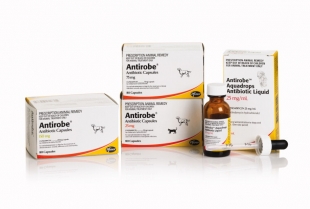Antirobe Capsules

Home / Species & Products / Cats / Antirobe Capsules

Antirobe is an antibiotic for the treatment of infected wounds, abscesses, dental infections and osteomyelitis in dogs and cats.
Antirobe contains clindamycin hydrochloride, a semi-synthetic member of the lincosamide class of antibiotics. Antirobe is the only clindamycin specially formulated and registered for cats and dogs in New Zealand.
Antirobe is indicated for oral administration to dogs and cats for the treatment of infected wounds, abscesses, dental infections and osteomyelitis caused by aerobic and anaerobic bacteria susceptible to clindamycin.
Safety: Antirobe has a good safety profile in dogs and cats. Dogs tolerated well doses of 300 mg/kg/day (27 times the recommended dose rate of 11 mg/kg/day). Cats tolerated 110 mg/kg/day for 15 days and 55 mg/kg/day for 42 days (10 times and 5 times the recommended dose rate of 11 mg/kg/day).
Compliance and Convenience: Antirobe enhances compliance and convenience with two oral formulations and four presentations. Antirobe can be given with or without food.
Palatable: Antirobe Antibiotic Capsules are tasteless and do not dissolve in the mouth, minimising stress for the animal and owner.
Mode of Action: Antirobe is a bacteriostatic and acts by inhibiting protein synthesis inside the bacterial cell. The effect is irreversible as it binds to the 50S subunit of the ribosome and prevents the binding of amino acids to ribosomes.
Absorption: Antirobe is rapidly and almost completely absorbed from the canine and feline gastrointestinal tracts. Clindamycin has better absorption and fewer adverse effects compared to lincomycin and the presence of food in the gastrointestinal tract does not decrease absorption of the drug.
Serum levels: Antirobe reaches peak serum concentrations within 75 minutes post oral administration. The half-life is 5 hours and therapeutic serum levels can be maintained by oral dosing at 5.5 mg/kg bodyweight every 12 hours.
Leucocytes: Antirobe is taken up rapidly by neutrophils with the peak concentration being 40 times greater than the extracellular concentration. Antimicrobial activity is maintained within the neutrophil and therefore reaching high concentrations at the site of infection. Antirobe is unique in its power to penetrate into white blood cells.
Distribution: Antirobe, being lipid soluble, is widely distributed in many body fluids and tissues, penetrating respiratory secretions, soft tissues, bones and joints. Antirobe even penetrates to effective concentrations in walled-off abscesses. Tissue concentrations generally exceed serum concentrations.
Metabolism and Excretion: Antirobe is mostly metabolised by the liver and excreted mainly in the file and to a lesser extent, via urine, as parent drug and active metabolites.
Antirobe is available in three presentations:
- 80 blister packaged capsules
- Carton of 80 blister packaged capsules Antirobe Capsules
- Carton of 80 blister packaged capsules
Treatment of dental infections, wounds and abscesses: Administer orally 5.5 mg/kg every 12 hours for 7–10 days, and for up to 28 days.
Treatment of osteomyelitis: Administer orally 11 mg/kg every 12 hours for at least 28 days.
DOSAGE TABLE
|
5.5mg/kg bid |
|||
|
CAPSULES |
|||
|
Bodyweight (kg) |
25mg |
75mg |
150mg |
|
2 – 5 |
1 |
- |
- |
|
6 – 9 |
- |
1 |
- |
|
10 – 14 |
- |
1 |
- |
|
15 – 19 |
- |
- |
1 |
|
20 – 29 |
- |
- |
1 |
|
30 – 39 |
- |
- |
2 |
|
40 – 49 |
- |
- |
2 |
|
50 – 59 |
- |
- |
3 |
If no clinical response is seen within 4 days, re-determine the diagnosis.
Animals with a history of hypersensitivity to preparations containing clindamycin or lincomycin. Because of potential adverse gastrointestinal effects, do not administer to rabbits, hamsters, guinea pigs or horses. Use with caution in animals receiving neuromuscular blocking agents.
Safety in gestating bitches, queens and breeding male dogs and cats has not been established.
Dry-pilling cats is not recommended. Administer orally with food and/or water. During prolonged therapy of one month or longer, periodic liver and kidney function tests and blood counts should be performed. Animals with severe renal and/or very severe hepatic disturbances accompanied by severe metabolic aberrations should be dosed with caution and serum levels monitored during high-dose clindamycin therapy. Safety in gestating bitches, queens or breeding male dogs and cats has not been established. Antagonism between clindamycin and erythromycin has been demonstrated.
Clindamycin sometimes causes overgrowth of non-susceptible organisms such as some clostridia and yeasts. Vomiting and diarrhoea have occasionally been observed.
Prescription Animal Remedy. Keep out of reach of children. For animal treatment only.
Zoetis Animal Health New Zealand Limited. Level 5, 8 Mahuhu Crescent, Auckland 1010, New Zealand. Tel: 0800 650 277, Fax: 0800 628 629. ANTIROBE is a registered trade mark of Pfizer Inc. or its subsidiaries. ACVM Registration No. A6893, A6894, A6895 & A8150. RVM; Available only under Veterinary Authorisation.
For technical enquiries please phone Zoetis Technical Services on 0800 650 277.

You are leaving the country website to access another site in the group.
Regulatory constraints and medical practices vary from country to country. Consequently, the information provided on the site in which you enter may not be suitable for use in your country.
